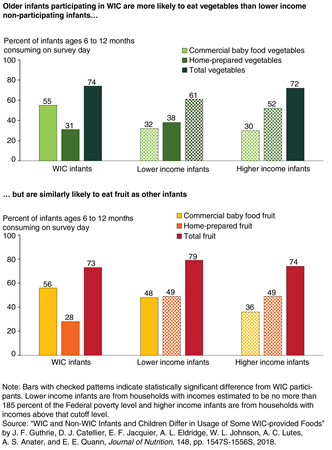Older Infants Participating in WIC Are More Likely To Eat Vegetables Than Low-Income Non-Participating Infants

USDA’s Special Supplemental Nutrition Program for Women, Infants, and Children (WIC) offers eligible participants food packages that are tailored to the nutritional needs of each participant category: nutritionally-at-risk low-income pregnant, breastfeeding, and postpartum women; infants (birth to 1 year old); and children up to 5 years of age. Participants are provided with paper vouchers or electronic benefit cards that can be redeemed for specified food and beverage items from retailers authorized to accept WIC benefits.
Since 2009, the food packages for older infants—those between the ages of 6 and 12 months—have included commercially prepared baby food fruits and vegetables: 128 ounces monthly for formula-fed and partially breastfed infants, and double that amount for breastfed infants. In some States, the WIC package for infants 9 months to 1 year old offers the option of vouchers for purchasing fruits and vegetables in place of some of the baby food fruits and vegetables. The addition of fruits and vegetables to the WIC package for older infants addressed American Academy of Pediatrics guidelines and research showing lower-than-recommended consumption of these foods by U.S. infants and toddlers. A recent analysis by an ERS researcher and colleagues found that older infants participating in WIC (WIC infants) had the same likelihood of eating fruits and vegetables as higher income infants not participating in the program (non-WIC infants) and a higher likelihood of eating vegetables than lower income non-WIC infants.
The researchers analyzed data from the Nestlé Research Foundation’s 2016 Feeding Infants and Toddlers Study, which interviewed a nationwide sample of parents about their infants’ and young children’s daily diets. Their analyses found that on the survey day, more than half of older WIC infants (6 months to 1 year old) ate commercial baby food vegetables (55 percent), a higher share than both lower income non-WIC infants (32 percent) and higher income non-WIC infants (30 percent) of the same age group. Also, within this age group, similar shares of WIC infants and lower income non-WIC infants ate home-prepared vegetables, such as mashed cooked carrots or peas. However, higher income non-WIC infants were more likely to eat home-prepared vegetables (52 percent) than were WIC infants (31 percent). When all sources are considered, WIC infants were more likely to eat any vegetable (74 percent) than lower income nonparticipants (61 percent), indicating the important role of WIC in promoting vegetable consumption among infants.
When the likelihood of eating fruit on the survey day was examined, there was no difference among the three groups of older infants. However, there were some differences in the source of the fruit eaten. Similar shares of WIC infants and lower income non-WIC infants ate commercial baby food fruits on the survey day, while higher income non-WIC infants were less likely to eat commercial baby food fruit than WIC infants. Both higher and lower income non-WIC infants were more likely to eat home-prepared fruit, such as mashed bananas, than WIC infants.
“WIC and Non-WIC Infants and Children Differ in Usage of Some WIC-provided Foods” by Joanne F. Guthrie, Diane J. Catellier, Emma F. Jacquier, Alison L. Eldridge, Wendy L. Johnson, Anne C. Lutes, Andrea S. Anater, and Erin E. Quann, Journal of Nutrition, 148, pp. 1547S-1556S, doi: 10.1093/jn/nxy157, December 2018


